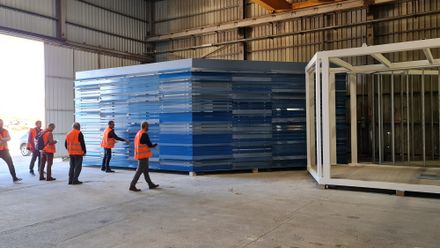
Tarragona Public Passenger Terminal
ARCHITECTS
Hombre De Piedra Arquitectos
LEAD ARCHITECTS
Juan Manuel Rojas Fernández, Laura Dominguez Hernández
DESIGN TEAM
Antonio Jiménez Rufo, Daniel Fernández Pineda, Rafael Blasco Ramírez, Jaime Fernández Moro, Rafael Brenes Luque, David Ribera Uría
INSTALLATIONS UNDER CONSTRUCTION
Xavier Ferré
RIGGER
Plàcid Alegret Sariñena
CALCULATION OF STRUCTURES AND INSTALLATIONS
Cqd Ingenieria
CALCULATION OF INSTALLATIONS
Jg Ingenieros
MAIN CONSTRUCTION
Serom
OFF SITE MODULAR CONSTRUCTION
Nevo
FACADE MATERIAL
Paneles De Fachada Isopan
STRUCTURES
Construcciones Metálicas Nemar
EXTERIOR CORRUGATED SHEET METAL
Europerfil
EXTERIOR CARPENTRY
Technal
COVER MATERIAL
Renolit
YEAR
2024
LOCATION
Spain
CATEGORY
Transportation, Rest Area
Text description provided by architect.
Faced with the challenge of an unpredictable future marked by rapid change, where needs shift quickly, we propose an architecture capable of evolving over time, allowing expansions, transformations, or reductions to adapt to new demands without losing its architectural qualities. It should even allow for simple and cost-effective dismantling if necessary.
Perhaps, rather than pursuing traditional, heavy, and eternal architecture, sustainability and current demands call for lightweight, modular architecture that facilitates future adaptations and aligns with modern production methods—no longer reliant on increasingly scarce traditional construction but on industrialized processes.
In this context, the Tarragona Public Passenger Terminal explores modularity and off-site industrialized construction.
However, instead of resorting to the conventional stacking of rectangular boxes, it proposes complex geometries inspired by tradition and the mathematics of plane tessellation.
These non-orthogonal geometries enhance passenger flow and enable spatial explorations that create a sculptural identity linked to Mediterranean architectural heritage.
The proposed geometry also represents a triumph of organic underwater forms over the rigidity typical of concrete port infrastructure.
The large scale of cruise ships offers passengers an aerial perspective, turning the roof into the building’s main façade. A unique grid reveals the interior geometry of irregular pentagons, all identical, crowned by large skylights evoking mollusk shapes.
This design nods to Mediterranean traditions, from Roman mosaics to Modernist trencadís. The architecture unpretentiously reflects the essence of an economical and sustainable construction.
Inside, the dynamic geometry is mirrored in the exposed metal ceiling structures, reminiscent of historic Catalan markets.
Natural light is designed to suggest an underwater landscape, creating a pleasant atmosphere that transforms transit into an enjoyable experience.
The lightness of a structure can be an indicator of its sustainability. The amount of mass mobilized reflects the use of material and energy resources.
In this case, the building’s weight is especially critical due to the limited load-bearing capacity of the artificial dock reclaimed from the sea.
A traditionally constructed building could not be anchored in this soil layer due to its weight, requiring piles over 25 meters long to reach the seabed.
The lightweight construction allowed for shallow foundations—a more sustainable solution both economically and environmentally.
This lightness, along with its off-site industrialized construction, contributes to environmental achievements: a 55% reduction in waste, 60% in CO₂ emissions, and 80% in water consumption compared to traditional construction averages.
It is easily expandable, dismantlable, relocatable, and recyclable, with an energy rating of "A." Moreover, its execution was completed in record time, minimizing the uneconomical occupation of the dock, disruptions to citizens, and environmental impact.
The modular industrialized construction, carried out in Almería, allowed most of the work to be finished in under 10 months, ensuring reliability and quality by avoiding the unpredictability and chaos of traditional construction, which relies on artisanal methods amid a shortage of skilled labor. Ultimately, the building is an adaptive architecture designed to meet today’s needs.























